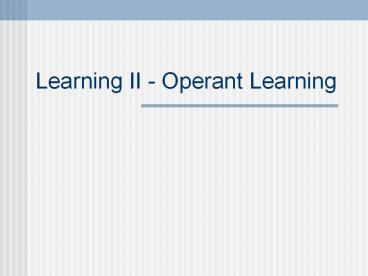Learning II - Operant Learning PowerPoint PPT Presentation
1 / 28
Title: Learning II - Operant Learning
1
Learning II - Operant Learning
2
How Do Operants and Respondents Differ?
- Operants are Emitted Respondents Elicited
- Operants Occur Because of Their Consequences
Respondents by Antecedents - 3) Operants Include a Wider Range of Behaviors
Respondents are/were Reflexes - 4) Operant Learning Produces New Behavior
Respondent - existing behavior to a new stimulus
3
The Four Term Contingency
- The First Term - R The Response
- R
- The Second Term - The Consequence
- R-----gtSr or Sr-
- The Third Term - The Discriminative Stimulus
(Sd) - SdRSr SdRS-r
- The Fourth Term - The Setting Event (SE)
4
The Four Term Contingency
- SD -------gtR--------gtS r ( -r)
- Setting Event
5
1st Term - The Response
- Behavior
- Response Classes
- Topographic
- Functional
- Geographic
6
Topographic Response Class
- Based on its form or appearance
- Examples
- running
- talking
- head-banging
7
Functional Response Class
- Different topographies have same effect on
environment - Examples
- Waving hands
- Yelling Stop
- Writing the word stop
8
Geographic Response Class
- Outside of our skin - Public Behavior
- Inside our skin - Private Behavior
9
Response Classes meansResponse Variability
- Variability means selection
- Selection by Consequences
- Consequences means response has an effect on
stimuli
10
Term - The Consequence
- Consequence means an event follows the response
- Consequence is defined functionally -- by its
effect on the response - Response - Consequence relationship is a
Contingency - an if-then relationship - Consequence determines if a response will
probably occur
11
Consequence is Defined by its Function
- What happens as a result of R---gt S
Contingency? - Strengthen
- Weaken
- No Effect
12
Five Consequences
- R-------gtS
- Response adds () Stim. Response increases
- R --removes--gt S
- Response subtracts(-) Stim. Response increases
- R ---------gtS
- Response adds () Stim. Response decreases
- R --removes--gtS
- Response removes S. Response decreases
- R ----/---gt
- Response has no effect. Stimulus is withheld
13
Positive Reinforcement
- R-------gtS
- Response adds () Stim. Response increases
- Name of Operation Positive Reinforcement
- Name of Stimulus Positive Reinforcer
- Examples
14
Negative Reinforcement
- R --removes--gt S
- Response subtracts(-) Stim. Response increases
- Name of Operation Negative Reinforcement
- Name of Stimulus Negative Reinforcer
- Examples
15
Punishment by Hurt(Positive Punishment)
- R ---------gtS
- Response adds () Stim. Response decreases
- Name of Operation Punishment by hurt
- Positive
Punishment - Name of Stimulus Negative Reinforcer
- Examples
16
Punishment by Loss(Negative Punishment)
- R --removes--gtS
- Response removes S. Response decreases
- Name of Operation Punishment by loss
- Negative
Punishment - Name of Stimulus Positive Reinforcer
- Responses which lose negative reinforcers
decrease - Examples
17
Extinction
- R ----/---gt
- Response has no effect. Stimulus is withheld
- Usually immediate effect - Extinction Burst
- Gradual decrease to Operant Level
- Difference with Negative Punishment
- Neg. Punishment Stimulus is removed
- Extinction Stimulus is withheld
18
Reinforcing Consequence
- Always a strengthening of behavior
- Increase in probability of occurrence
- Increase in magnitude, etc.
- Positive Reinforcement - Response Adds Stimulus
- Negative Reinforcement - Response Removes Stimulus
19
What Changes?--The Development of Reinforcing
Stimuli
- Primary Reinforcer
- Present at Birth
- Universal
- Acquired (Secondary) Reinforcers
- Associated with other reinforcers
- Learned
- Non-universal and Generalized
20
Primary Reinforcers
- Present at Birth
- Universal
- Examples
- Food
- Liquid
- Touch
- Smell
- Air
21
(No Transcript)
22
(No Transcript)
23
Shaping
- Reinforcement of Successive Approximations
- Important for the Development of New Behaviors
24
Term - Discriminative Stimulus
- SD or Sd
- Sets the occasion for or signals response
- CUE
- Correlated with response having a consequence
- An Sd is also a reinforcing stimulus
- Sr or S-r
25
Chaining
- Links of 3 Term contingencies
- Held together by consequence at end
- Forward Chaining
- Start at begining and work toward end
- Backward Chaining
- Start at last Contingency work forward
26
Operant Learning and Dynamical Principles of
Development
27
Coalescent Organization Revisited
28
Another Look at the Emergence of Dynamic
Attractors
- Remembering the Importance of Leading Parts or
Control Parameters - The Issue of Nonlinearity
- Learning and Dynamical Systems in Summary

